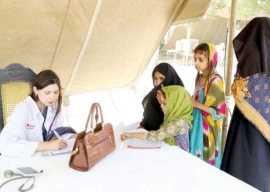
About 70% work for conversion of educational institutions to solar power in Punjab has been completed.
According to sources, more than 10,000 primary schools have been converted to solar energy under an $86 million project funded by the Asian Development Bank (ADB). Work has also been started to use solar power in shrines.
A Chinese company will complete a 100 MW solar power plant in Layyah this year in partnership with a Pakistani firm, while 550kW hybrid solar-biogas projects will be set up in Sammundri and Vehari at a cost of Rs282 million.
Officials concerned claim that completion of the Punjab Solarisation Project will save the province up to Rs 40 billion annually. Work on the project is in full swing, they added.
The provincial government is reportedly working to reduce the annual financial burden by promoting the environment-friendly solar energy.
In this regard, with the support of the Asian Development Bank, more than 40 universities and 15,000 schools in Punjab are being rapidly converted to solar energy at a cost of $86 million. So far, more than 10,000 schools have been converted to solar energy.
A 2.5MW solar power project at Islamia University Bahawalpur will also be completed this year. It is expected to save the university Rs55 million in annual bills. In addition, an eight-storey ‘net zero’ building of the Punjab Energy Department will be constructed in Lahore with ADB funding. It will be a unique building of its kind in terms of energy use.
The Chinese company is working on a 100MW solar power plant in Chobara tehsil of Layyah in partnership with the Pakistani firm. The project is scheduled to be completed during the current year to provide affordable and environment-friendly energy.
The cost of electricity generated from the plant will be Rs6.5 per unit, while that for the 100MW Quaid-e-Azam Solar Power Park has exceeded Rs25 per unit.
Read UNDP backs Pindi’s urban regeneration plan
The Punjab government is also working for solarisation with its own resources under the provincial annual development programme. The projects include hybrid solar and biogas plants to be set up at a cost of Rs282 million in Sammundri and Vehari. Their generating capacity will be 550kW.
According to official documents, there are more than 95,000 electricity connections for various departments of the government of Punjab. They include the departments of education, agriculture, police, health, irrigation, excise and taxation, and communications and works.
The Punjab government pays more than Rs37 billion annually for the electric supply and the amount is likely to continue to increase in the coming years, which will be a heavy burden on the treasury.
The government believes that completion of the new Punjab Solarisation Project will reduce the annual electricity bill and the amount of money saved can be used for other development works.
Work has also been started to convert 20 prominent shrines in the province to solar energy. They include Data Darbar, Darbar Baba Bhuleh Shah and the shrines of Shah Hussain, Hazrat Sultan Bahoo, Shams Tabrez, Bahauddin Zakaria Multani and others. After the completion of energy audit of all the shrines, they will be converted to solar energy.
Punjab Energy Minister Akhtar Malik said while talking to The Express Tribune that through the initiatives of the government, electricity supply has been provided through solar energy in those areas where it was not available earlier. “With the steps taken by the government, facilities are being brought to the doorsteps of the people so that they can get relief,” he added.
Published in The Express Tribune, January 26th, 2021.


1732271743-0/diddy-(45)1732271743-0-165x106.webp)



1726722687-0/Express-Tribune-Web-(9)1726722687-0-270x192.webp)











COMMENTS
Comments are moderated and generally will be posted if they are on-topic and not abusive.
For more information, please see our Comments FAQ